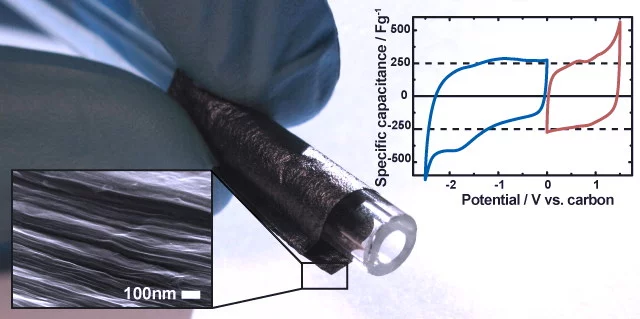One way to utilize graphene and its’ outstanding specific surface area of 2630 m2g-1 for supercapacitor electrodes is by preparing a so called free-standing graphene paper. Such a flexible, conductive graphene-paper electrode was prepared by a flow-directed filtration of graphene oxide dispersion followed by a gentle thermal reduction treatment of the filtrate. The prepared partially reduced graphene oxide paper (GOPpr) showed a dense packing of graphene sheets with a distinct interlayer distance of 4.35 Å. Its electrode quality for energy storage applications was tested by an electrochemical characterization in the aprotic electrolyte tetraethylamonium-tetrafluoroborat in acetonitrile (1M TEABF4 / AN) which is commonly used for supercapacitors. During the first positive or negative charging sweep GOPpr featurs an electrochemical activation. As a result the GOPpr becomes accessible for ion insertion and release. The achieved specific capacitance in galvanostatic discharge measurements reached up to 199 Fg-1 at 0.1 Ag-1 for a positively activated and polarized electrode. Even at high specific currents of 10 Ag-1 this value did not drop below 145 Fg-1. An even higher specific capacitance was determined from cyclic voltammetry where the positively activated electrode yielded up to 270 Fg-1 during the discharge sweep. It’s flexible nature, the simple processability and the outstanding rate handling capability for the anodically activated positively polarized electrode containing neither a conductive agent nor any polymeric binder is among the best reported in literature for organic electrolytes. Therefore GOPpr is a very promising candidate for a positive electrode material for energy storage devices relying on flexible materials and ion insertion / double layer formation.
Further publications: Electrocatalysis and Interface Group

